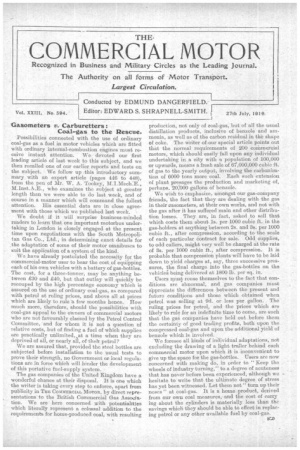Gasometers v. Carburetters : Coal-gas to the Rescue.
Page 1

If you've noticed an error in this article please click here to report it so we can fix it.
Possibilities connected with the use of ordinary coal-gas as a fuel in motor vehicles which are fitted with ordinary internal-combustion engines must receive instant attention. We devoted our first leading article of last week to this subject, and we then recalled one of our earlier, reports and tests on the subject. We follow up this introductory summary with an expert article (pages 446 to 448), from the pen of Mr. W. A. Tookey, M.Inst.A.E., who examines the subject at greater length than we were• able to do last week, and of course in a manner which will command the fullest attention. His essential data are in close agreement with those which we published last week.. We doubt if it will surprise business-minded readers to learn that one important motorbus under. taking in London is closely engaged at the present time upon negotiations with the South Metropolitan Gas Co., Ltd., in determining exact details for _the adaptation of some of their motor omnibuses to suit the application of a system of the kind.
We have already postulated the necessity for the commercial-motor user to bear the cost, of equipping each of his own vehicles with a battery of gas-bottles. The cost, for a three-tonner, may be anything between £.30 and 140, but that outlay will ,quickly be recouped by the high percentage economy which is assured on the use of ordinary coal-gas, as compared with petrol at ruling prices, and above all at prices which are likely to rule i few mouths hence. Row much more, therefore, should the possibilities with coad-gas appeal to the owners of commercial motors who are not favourably classed by the Petrol Control Committee, and for whom it is not a question of relative costs, but of finding a fuel of which supplies are practically unlimited, at a time when they are deprived of all, or nearly all, of their petrol? We are assured that, provided the steel bottles are subjected before installation to the 'usual tests to prove their strength, no Government or local regulations are in force which will hinder the development of this portative fuel-supply system. The gas companies of the United Kingdom have a wonderful chance at their disposal. It is one which the writer is taking every step to enforce, apart from publicity in THE COMMERCIAL MOTOR, by direct representations to the British Commercial Gas Association. We are here concerned with potentialities which literally represent a colossal addition to the requirements for home-produced coal, with resulting production, not only of coal-gas, but of all the usual distillation products, inclusive of benzole and ammonia, as well as of the carbon residual in the shape of coke. The writer of our special article points out that the normal requirements of 200 coinmercial motors, which should easily fall upon any individual undertaking in a city with a population of 100,000 or upwards, means a fresh sale of 61,000,000 cubic ft_ of gas to the yearly output, involving the carboniz-ation of 6000 tons more 'coal. • Each such extension of .plant presages the production and marketing of, perhaps, 20:000 gallons of benzole.
We wish to emphasize, amongst our gas-company friends, the fact that they are dealing with the gas in their gasometers, at their own -works, and not with the gas after it has suffered main and other distribution losses. They are, in fact, asked to sell that which costs them about 1s. per 1000 cubic ft. in the gas-holders at anything between 2s. and 3s. per 1000 cubic ft., after compression, according to the scale of each particular Contract for sale. Odd supplies, to odd callers, might very well be charged at the rate of 3s. per 1000 cubic ft., after compression. It is prObable that compression plants-will have to be laid. down to yield charges at, say, three successive pressures, the final charge into the gas-bottles on the vehicle; being delivered at 1800 lb.. per sq. in.
.Users must rouse themselves to the fact that conditions are abnormal, and gas companies must a`ppreciate the differences between the present and future conditions and those which obtained when petrol was selling at 9d. or less per gallon. The ruling prices for petrol, and the prices which are likely to rule for an indefinite time to come, are such that the gas coMpanies have held out before them the certainty of good trading profits, both upon the compressed coal-gas and upon the additional yield of benzole which is involved. • We foresee all kinds of individual adaptations, not • excluding the drawing of a light trailer behind each commercial motor upon which it is inconvenient to give up the space for the gas-bottles. Users are now concerned with making do, in order to "Keep the wheels of ind.tistry turning," to a degree of acuteness that has never before been experienced, although we hesitate to write that the ultiMate degree of stress has yet been witnessed. Let them not " turn up their noses" at coal-gas. It is a home product, derived from our own coal measures,and the .cost of carry ing about the cylinders is materially less than the savings which they should be able to effect in replacing petrol or any other available fuel by coal-gas.






















